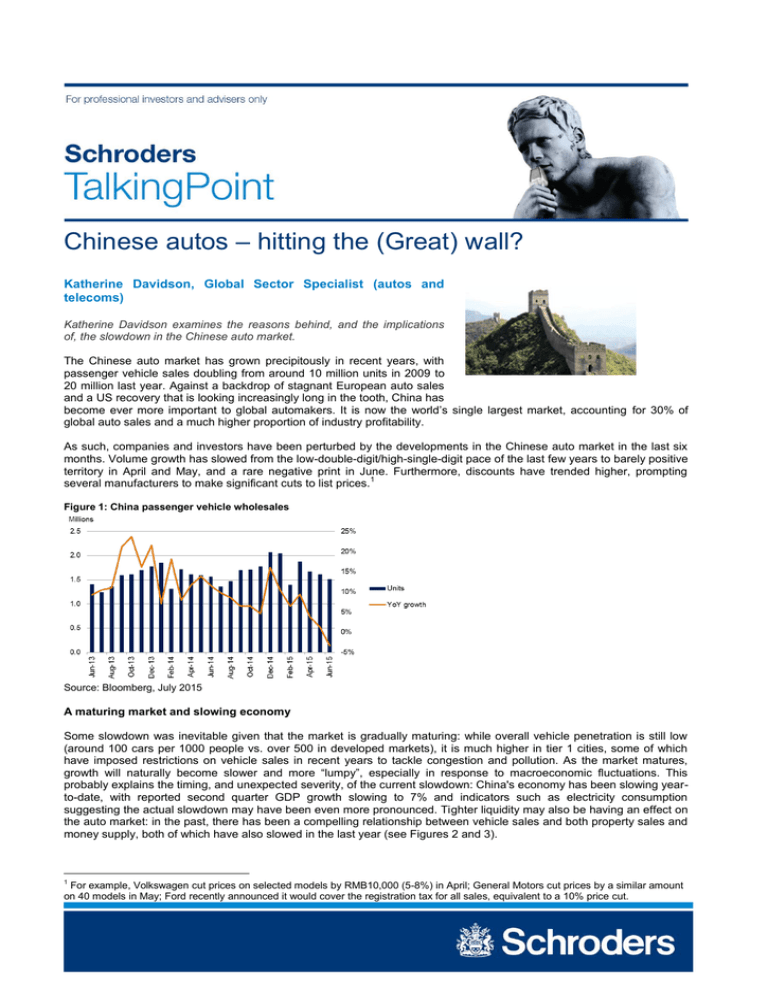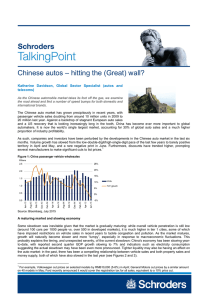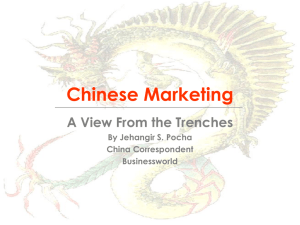– hitting the (Great) wall? Chinese autos
advertisement

Chinese autos – hitting the (Great) wall? Katherine Davidson, Global Sector Specialist (autos and telecoms) Katherine Davidson examines the reasons behind, and the implications of, the slowdown in the Chinese auto market. The Chinese auto market has grown precipitously in recent years, with passenger vehicle sales doubling from around 10 million units in 2009 to 20 million last year. Against a backdrop of stagnant European auto sales and a US recovery that is looking increasingly long in the tooth, China has become ever more important to global automakers. It is now the world’s single largest market, accounting for 30% of global auto sales and a much higher proportion of industry profitability. As such, companies and investors have been perturbed by the developments in the Chinese auto market in the last six months. Volume growth has slowed from the low-double-digit/high-single-digit pace of the last few years to barely positive territory in April and May, and a rare negative print in June. Furthermore, discounts have trended higher, prompting 1 several manufacturers to make significant cuts to list prices. Figure 1: China passenger vehicle wholesales Source: Bloomberg, July 2015 A maturing market and slowing economy Some slowdown was inevitable given that the market is gradually maturing: while overall vehicle penetration is still low (around 100 cars per 1000 people vs. over 500 in developed markets), it is much higher in tier 1 cities, some of which have imposed restrictions on vehicle sales in recent years to tackle congestion and pollution. As the market matures, growth will naturally become slower and more “lumpy”, especially in response to macroeconomic fluctuations. This probably explains the timing, and unexpected severity, of the current slowdown: China's economy has been slowing yearto-date, with reported second quarter GDP growth slowing to 7% and indicators such as electricity consumption suggesting the actual slowdown may have been even more pronounced. Tighter liquidity may also be having an effect on the auto market: in the past, there has been a compelling relationship between vehicle sales and both property sales and money supply, both of which have also slowed in the last year (see Figures 2 and 3). 1 For example, Volkswagen cut prices on selected models by RMB10,000 (5-8%) in April; General Motors cut prices by a similar amount on 40 models in May; Ford recently announced it would cover the registration tax for all sales, equivalent to a 10% price cut. Schroders Talking Point For professional investors or advisers only Figure 2: Passenger vehicle (PV) sales vs. property sales, year-on-year (YoY) Source: Bloomberg, July 2015 CLSA, Figure 3: PV sales vs. M2 growth, YoY CEIC Source: We have also heard the suggestion that the bull market (bubble?) in the Chinese stockmarket crowded out vehicle sales in the first half: while almost a third of domestic investors surveyed by brokerage firm CLSA in May said they would spend their winnings on a new car, while the rally continued they may have been unwilling to cash out and tie their money up in an illiquid asset. While seemingly far-fetched, one data point supporting this hypothesis is that, for premium cars, cash sales fell in the fourth quarter of 2014 and the first quarter of 2015 while financed sales continued to grow at a doubledigit pace. That said, the disorderly collapse in Chinese stock prices over the last month may have wiped out much of the potential wealth effect, and is unlikely to be positive for consumer confidence and big-ticket spending. Domestic brands gaining market share So far, so banal. Yet far more surprising, and alarming (for foreign investors), has been the dramatic swing in market share towards Chinese domestic brands in the last six months. After several years of steady decline - from a high of over 45% in 2010 to less than 38% last year – domestic share rebounded to almost 43% in the first quarter of 2015. Given the slowdown in the overall market, this has meant that domestics have captured all the growth so far this year, while overall 2 sales by joint venture (JV) brands have been flat. In fact, market leaders General Motors and Volkswagen have seen sales decline around 5% in the first half. Figure 4: Domestic vs. foreign share of passenger vehicle sales Source: Macquarie 2 N.B. Chinese law requires any foreign OEM manufacturing in China to form a joint venture (JV) with a local partner, designed to ensure “knowledge transfer” to Chinese companies and accelerate the development of the domestic industry. Vehicles produced by the JV are co-branded with the names of the local and foreign partners – e.g. Changan Ford – but are designed by the foreign partner and in most cases are identical to international models, so are regarded by customers as foreign products. As such, in this paper we use the terms “JV brands” and “foreign/international brands” interchangeably. 2 Schroders Talking Point For professional investors or advisers only One relatively benign explanation is that the government reinstated subsidies of RMB 3000 for small (<1.6L) and fuel3 efficient vehicles in September 2014. Another explanation relates to the rapid growth seen in the small/budget SUV market, which is dominated by domestic manufacturers. Growth in the SUV market The share of SUVs in overall vehicle sales has continued its seemingly inexorable upward march, reaching new highs of almost 30% of overall passenger vehicle sales in May. This is a global trend (see Figure 5) but has been particularly marked in China, where poor road quality and safety seem to drive even higher SUV preference. This is aggravated by the fact that sales growth is faster in lower tier cities and central and western provinces, where road quality is even more of an issue and many owners need their single vehicle to serve both as family transport and a workhorse for goods transportation, haulage etc. While SUVs are generally seen as the preserve of repeat buyers (first-timers tend to prefer small hatchbacks), this appears to be changing in China. Falling fuel prices have also helped, as SUVs have comparatively poor fuel economy and lower-income buyers are most sensitive to fuel costs. Figure 5: SUV penetration by country: 1Q 2013 vs. 1Q 2015 Source: IHS Global Insight, C.A.D. and Bernstein analysis These factors combined have meant that small/budget SUVs have been by far the fastest-growing segment in the market, capturing essentially all of the overall volume growth since the last quarter of 2014. As mentioned above, domestic manufacturers have a near-monopoly on this market segment, with only a few JV SUV models available below RMB 100k. The average list price for a domestic brand SUV is less than half that of a JV model. Domestics have also benefited from a particularly strong spate of new model launches in this segment: more than 30 SUVs priced below RMB 130,000 were launched in 2014 and the first half of 2015, and more than 10 more are expected to hit the market before year-end. By contrast, the JV brands have only launched 2 budget SUVs and only two-thirds as many SUV models as the domestics overall. Chinese consumers, seemingly more so than their counterparts in more mature markets, overwhelmingly prefer new models. A quick glance at the bestselling SUV models in the first half of 2015, reveals that almost all were relatively new, cheap, and small. The top 10 of these contains only two JV models – Volkswagen’s Tiguan and Ford’s Kuga – versus seven out of 10 in 2014. As a result, domestics have increased their share of the overall SUV market from less than 40% in September last year to a whopping 55% today. While partly down to lucky timing (many high-volume JV models were in run-off in the first quarter ahead of second quarter or second half refreshes), we must also give the domestics credit for significantly improving their product quality and content levels, and for producing models that clearly satisfy current consumer preferences. In part because of their ”copycat” manufacturing (experts tell us the Chinese tend to reverse engineer foreign models rather than designing from scratch), Chinese brands have much shorter development cycles and are able to churn out new models catering to prevailing tastes. While the average age of JV products has also fallen significantly in the last decade, JV model cycles are still largely dictated by those of their foreign parent: a standard 4-6 year cycle. As such, even General Motors – an early entrant and the second largest JV in China – largely missed the SUV boom, and Volkswagen – the largest – is scrabbling to develop a low-end SUV to compete with the domestics. While, ceteris paribus, Chinese consumers may still prefer JV brands, given a choice of a new domestic SUV and a foreign sedan at the same price point, the domestic product is increasingly compelling. In our view, this has been the main factor behind the spate of price cuts and promotions at JV brands. 3 Currently 102 models from 28 manufacturers are eligible, mostly domestic names. The models must have engine displacement <1.6L and fuel efficiency of <5.6L/100km. 3 Schroders Talking Point For professional investors or advisers only Will this share shift last? This begs the question - how sustainable is the recent share shift, and could it go even further? In the near-term, the JV brands will benefit from a number of significant refreshes in the second half, and their model launch schedule is also 4 more comparable to the domestics’ next year. Foreign brands would also be more likely to benefit if and when investors cash in any remaining stockmarket gains. In fact, domestic market share has already begun to drop off, falling back to 39% for the second quarter and as low as 37% in June (as a result of a slowdown in overall volumes rather than any improvement in sales momentum at JVs). However, we expect the domestic market share to stabilise at a somewhat higher level than seen in the last couple of years, primarily due to further increases in SUV penetration at the bottom end of the market (see Figure 7 below). Interesting data from Bernstein shows that rising SUV penetration in the budget segment is largely ”catch-up”, as it already stands at 40% in higher priced segments. Their view is that, until 2014, there were very few credible SUV models available at this lower price point so there was high pent-up demand, but with ever more product coming online this is 5 clearly no longer a problem. There is also a good chance that the small vehicle subsidy is extended beyond the original deadline of year-end 2015. Figure 7: SUV penetration by price point Source: CAAM and Bernstein analysis As such, we believe the JV brands will face increasingly credible competition from the domestics, especially as both seek to capture volume from first-time buyers in poorer parts of the country. This represents a significant change versus the last few years, when most of the domestics were generally deemed to be operating in a different market segment to the JVs, with the gap in product quality so extreme that relative pricing was not relevant. Nowadays, survey data suggests that around half of industry professionals believe a price gap of less than 20% would be sufficient for customers to choose a domestic vehicle over a comparable JV model. While this still allows for a sizeable premium, JV prices for lower-spec vehicles are likely to remain under pressure given the domestics are selling half-decent SUVs for as little as RMB 70,000 (£7000!). JVs will struggle to compete at this price point given their higher cost structures versus domestic players, who generally have plenty of excess capacity and benefit from generous state subsidies. The other issue for the JV brands is that they will be also face increasing competition at other end of their model line-up, on the largest, most-profitable models, by entry-level premium models. The premium marques are increasing their local production which allows them to avoid punitive (25%) import duties and sell smaller vehicles at a competitive price. We believe mass market JVs risk being squeezed between the domestics and the premium players, implying that margins – which have been remarkably high in recent years – will have to normalise. Volkswagen reported an astonishing 18.3% operating margin at its Chinese JV operations in 2014 versus just 6.6% in its consolidated passenger car business (despite the latter also including the very profitable Porsche brand). While this is an extreme example, almost all global manufacturers have been making supernormal profits in China and will experience pressure as this normalises, both via equity income from the JV and in the consolidated business due to lower income from royalties and spare parts sales to the JV. Tomorrow - the world? The bigger medium-term issue for global manufacturers is whether the Chinese domestic brands can move up the value chain, producing cars able to compete at higher price points in the Chinese market and capture “trade-up” volumes. If so, 4 Exane expect both domestics and JVs to launch seven new SUVs in 2016, with the JVs refreshing an additional 4 models versus the domestics’ three. JVs also have better planned launches in 2017, though there is more upside risk to the domestic figure given shorter development cycles. 5 “Credible” in this context is defined as models with sales of more than 15,000 units per quarter. 4 Schroders Talking Point For professional investors or advisers only they would also be able to compete more broadly in global auto markets. This would impose a deflationary force on global auto pricing, similar to that caused by Chinese exports in other sectors (clothing, electronics etc.) over the last decade. On this point we remain sceptical, for now. There is no denying that Chinese brands have made genuine and significant improvements in product quality in recent years. Back in 2012, Bernstein analysts worked with a leading engineering consultant to conduct a unique “teardown analysis” of two Chinese-made vehicles. Their findings suggested Chinese manufacturers were still far off producing a vehicle that was up to global standards. This perhaps led to complacency among the investor community. While there is clearly huge variance across Chinese brands, some have definitely raised their game: in the latest JD Power China Initial Quality Study (IQS – see Figure 8), Chinese brands on average continued to close the gap with foreign manufacturers, and six domestics scored better than the mass market average. The highest-ranking domestic marque was Guangzhou Auto’s “Trumpchi”, which achieved the same score as Volkswagen’s Skoda. While some (smaller) domestic brands are 6 still obtaining zero stars on NCAP safety tests, safety for the mainstream brands is vastly improved and a Chinese-made model was first awarded the full five stars as early as 2013. Bernstein 2012 teardown analysis (Great Wall H5) “Amateur fixes” in electrical system “Victorian” drive belts Source: Bernstein research Figure 8: JD Power China IQS 2014 PP100 – Problems per 100 vehicles experienced in the first two to six months of ownership Source: JD Power Domestics still have a long way to go Chinese-made cars have come a long way but, in our view, the leap from “poor” to “good enough” is easier than the next stage of transition: making truly globally competitive vehicles. This will require a step-change in engineering expertise – distinct from manufacturing – and the approach to product development, rather than just reverse engineering and adding lots of foreign content. One engineering consultant in a recent Bernstein survey said that, while domestic manufacturers are now able to produce cars that are satisfactory on the outside, they are not making as much progress on internal features such as vehicle integration and durability. This chimes with comments we have heard during our own scuttlebutt on the topic, with industry consultants citing poor execution, the cutting of corners on product development and testing, a lack of basic automotive expertise among engineering graduates (most of whom have never had a car), and insular and hierarchical management. One professional told us that, in terms of engineering expertise, the Chinese are still 10-12 years behind global manufacturers. Recent attempts by the most competent of the domestics – Great Wall – to launch higher-end products (priced at RMB 230-270k) have not been encouraging. The H8 model was repeatedly delayed due to 6 5 The New Car Assessment Programme (NCAP) is a car safety performance assessment programme. Schroders Talking Point For professional investors or advisers only engineering problems, finally launching in April 2015 versus original plans for January 2014, and the H9 has seen volumes wane since soon after its November 2014 launch. Speed bumps ahead Bulls will point to the example of the Korean automakers, who initially struggled to break into overseas markets in the early 1990s with their cheap but low-quality cars. However, due to investments in design and manufacturing, the quality of Korean vehicles vastly improved over subsequent decades, closing the gap versus the Japanese by the mid-2000s. In the most recent JD Power US Initial Quality Study, the Korean marques ranked highest among mass market brands, well 7 ahead of the Japanese. This sets an encouraging precedent for the Chinese domestics, even if it takes a couple of decades. We would point out one key difference between the Korean domestics in the 1990s and the Chinese today: the Koreans started from a position of strength in their domestic market. Thanks largely to protectionism, the Korean brands went unchallenged at home until the 2000s, and still hold almost 80% market share, allowing them to develop vehicles, build a captive supply chain, and achieve efficient scale in a safe environment before having to compete with global peers. By contrast, the Chinese automakers have faced overseas competition from day one, and are also hampered by extreme fragmentation of the domestic industry. There are almost 200 local brands – in part, a function of each local government wanting its own 8 “champion” – and a significant minority have production volume of precisely zero. The other issue for domestics is that, despite product improvements, their brand equity is low: even domestic consumers still appear to have a strong preference for foreign brands, providing the price gap is not too extreme, and it is hard to imagine Western buyers embracing Chinese-made cars. While this has begun to change in other sectors – in particular 9 mobile phones, where the home-grown Xiaomi and Huawei brands now outsell Samsung – preferences are likely to shift more slowly in autos. The product life is much longer, outlay much larger, prestige factor (arguably) higher, and – critically – safety concerns impose a much higher hurdle. Almost 90% of industry professionals surveyed believed that domestic brand car owners would switch to a foreign brand if they could afford it, citing quality, durability, safety and brand as the key areas where domestic brands lag. Figure 9: Where do domestic branded cars most lag behind foreign competitors? Note: n=719 Source: Autoju.com and Bernstein analysis Domestics making headway in emerging markets Great Wall now has a few dealerships in Australia and the UK, but we believe it will still be some time before the Chinese really challenge Western manufacturers on their home turf. That said, they are already making headway in emerging markets, particularly in frontier markets where price-sensitivity is high and branding less relevant. Some Chinese brands probably make all their profits overseas, having carved out a profitable niche serving markets too small, difficult or “controversial” to attract many global automakers such as Iran, Iraq, Russia and sub-Saharan Africa. While unthreatening today, this may pose a bigger problem for global automakers if the Chinese begin to encroach on more mainstream emerging markets like ASEAN and Latin America, which are generally very profitable and will also drive most of the future growth for the global auto industry. 7 2nd and 4th place overall, with Porsche and Jaguar in 1st and 3rd place respectively; Toyota was the highest-ranked Japanese mass market brand in 10th place. The IQS measures the number of problems experienced by vehicle owners in the first 90 days of ownership. 8 Per personal correspondence with the China Association of Automakers in May 2014, the figure was 48 companies with zero production. 9 Based on shipment volumes in the first quarter of 2015. IDC Asia/Pacific Quarterly Mobile Phone Tracker, May 2015. 6 Schroders Talking Point For professional investors or advisers only Implications for investors The preceding discussion has covered a lot of ground, by what are the key implications for investors? - The slowdown in Chinese car sales is partly driven by the macro environment and liquidity, but signals a shift to a more mature auto market. While we still believe sales will grow faster than the developed world, growth will be ”lumpier” and more vulnerable to cyclical factors, and investors will have to pay more attention to model cycles. - Some of the recent surge in domestic brand market share is likely temporary, but has alerted overseas investors to the significant advances made by domestic brands in recent years. We see the domestic brands’ share of the market stabilising at a higher level than in recent years, and believe JVs will continue to feel price pressure on lower-spec vehicles, especially as more growth comes from inland China. JVs need to continue their efforts to produce more vehicles tailored to local tastes, and refresh models more frequently. - JV profitability will normalise from inflated levels. Global investors may get a nasty surprise as they realise global manufacturers had higher China exposure than they first thought, due to hidden profits from parts sales and royalties. - We prefer the premium marques, as they will benefit from rising incomes, increasing financing penetration and trade-up demand as the market matures. Plus, they are essentially immune to direct domestic competition. - We believe global suppliers (and, to a lesser extent, tyres) have a longer runway for growth in China, as the domestics seek to raise their standards by installing more foreign content. There are no domestic competitors for global tier 1 suppliers, and we do not believe supernormal profits for the suppliers have been as extreme as for JVs. - Chinese brands are unlikely to threaten global automakers on their home turf in the foreseeable future, but may capture a higher share of industry growth and profits by targeting emerging market niches. The Chinese are likely to remain acquisitive in their efforts to move up the value chain (for example: Geely acquiring Volvo, Dongfeng buying a stake in Peugeot-Citroen). Picking a winner amongst the domestic brands is tough and the industry experts we have spoken to did not have a consistent favourite. Profitability for the local players is also likely to deteriorate as competition intensifies and growth slows. While Chinese brands are unlikely to encroach on Western auto markets in the short-to-medium term, investors should be wary of being complacent and closely monitor the progress being made by the domestic brands, bearing in mind the Korean example. A change in brand perception by domestic customers, especially among younger buyers and those outside tier 1 and 2 cities would signal a potential shift in the domestic market. Important information: The views and opinions contained herein are those of Katherine Davidson, Global Sector Specialist, Global and International Equities, and may not necessarily represent views expressed or reflected in other Schroders communications, strategies or funds. Past performance is not a guide to future performance and may not be repeated. The value of investments and the income from them may go down as well as up and investors may not get back the amounts originally invested. Exchange rate changes may cause the value of any overseas investments to rise or fall. The forecasts included should not be relied upon, are not guaranteed and are provided only as at the date of issue. Our forecasts are based on our own assumptions which may change. We accept no responsibility for any errors of fact or opinion and assume no obligation to provide you with any changes to our assumptions or forecasts. Forecasts and assumptions may be affected by external economic or other factors. This document is intended to be for information purposes only and it is not intended as promotional material in any respect. The material is not intended as an offer or solicitation for the purchase or sale of any financial instrument. The material is not intended to provide, and should not be relied on for, accounting, legal or tax advice, or investment recommendations. Information herein is believed to be reliable but Schroder Investment Management Ltd (Schroders) does not warrant its completeness or accuracy. No responsibility can be accepted for errors of fact or opinion. This does not exclude or restrict any duty or liability that Schroders has to its customers under the Financial Services and Markets Act 2000 (as amended from time to time) or any other regulatory system. Issued by Schroder Unit Trusts Limited, 31 Gresham Street, London, EC2V 7QA. Registered Number 4191730 England. Authorised and regulated by the Financial Conduct Authority. For your security, communications may be taped or monitored. 7






